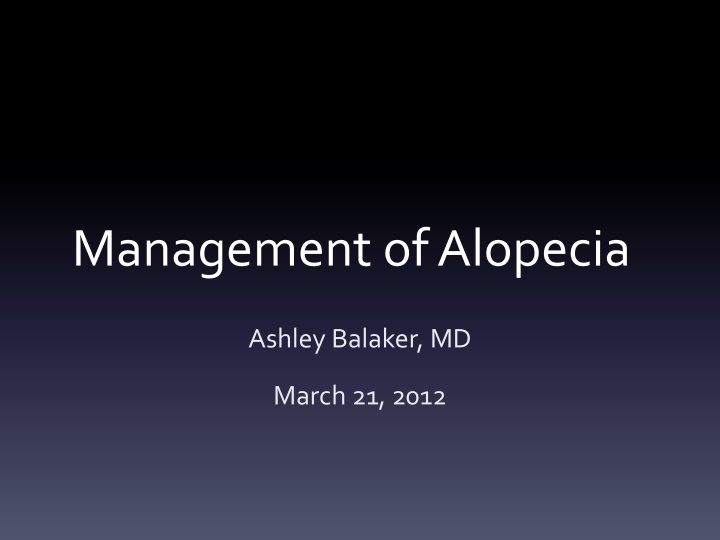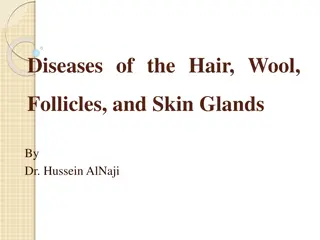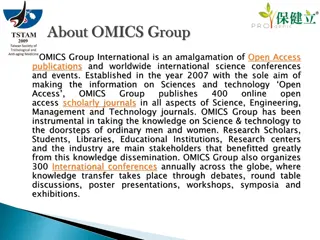Comprehensive Overview of Alopecia Management
Explore the causes, classification, medical therapy, surgical management, patient evaluation, and more aspects related to alopecia (hair loss) in both men and women. Understand the different treatment options available, including medications like Finasteride and Minoxidil, and surgical procedures to restore natural hairlines. Dive into the specifics of androgenic alopecia, patient assessment criteria, and the distinctions in treatment between men and women.
Download Presentation

Please find below an Image/Link to download the presentation.
The content on the website is provided AS IS for your information and personal use only. It may not be sold, licensed, or shared on other websites without obtaining consent from the author.If you encounter any issues during the download, it is possible that the publisher has removed the file from their server.
You are allowed to download the files provided on this website for personal or commercial use, subject to the condition that they are used lawfully. All files are the property of their respective owners.
The content on the website is provided AS IS for your information and personal use only. It may not be sold, licensed, or shared on other websites without obtaining consent from the author.
E N D
Presentation Transcript
Management of Alopecia Ashley Balaker, MD March 21, 2012
Causes of Alopecia Burns Traction Dermatitis Autoimmune disease Neoplasm Radiation Chemotherapy Androgenic alopecia most common in men and women
Androgenic Alopecia Affects scalp follicles Genetically susceptible to androgen inhibition Terminal hairs vellushairs Frontotemporaland crown regions
Medical Therapy Finasteride(Propecia) 1mg/day Competitive and specific inhibitor of coversionof testosterone to DHT Sexual side effects (loss of libido and potency) Minoxidil(Rogaine), 2 or 5% Initially found to have side effect of hypertrichosis K+ channel opener and vasodilator Unknown mechanism for hair growth
Surgical Management Restore natural frontotemporalhairline Avoid designs that require unnatural hairstyles
Patient Evaluation History and physical Expectations Age may need to delay until older if unsure about future balding in donor areas Donor area hair density (>8 hairs in 4mm circle) Hair type and skin color
Women Rarely have Norwood type pattern Hair may be thinned Hormonal and autoimmune causes more prevalent Minoxidil2% 1stline tx, Finasteridenot shown to be of benefit in women
Anesthesia Local vs. general Sedative then local (1% Lido w/ epi) Regional frontal, occipital and temporal nerve blocks Then wide field circumferential scalp block
History of hair autografts Okuda 1stto describe use of full thickness hair bearing autografts Orentreich1959 punch grafts in U.S.
Donor harvesting Donor area Anterior limit: vertical line through EAC Superior limit: horizontal line at superior attachement of auricle Multiblade knife to remove parallel strips of scalp (1.5 - 3mm width) Max total width of 1cm to prevent tension on closure of donor site
Donor harvesting If multidirectional hair growth, then harvest single 1cm strip w/ scalpel Trim hair to 3mm, infiltrate scalp with saline to tense scalp skin Cut parallel to hair follicles Close with 4-0 nylon suture, minimize tension
Preparing follicular units Trim excess subQfat, leave 2mm below follicle Trim to create teardrop shaped graft
Recipient site 2-4 transplant sessions Holes made with trephine punch or scalpel Holes made at angle to mimickoriginal hair growth pattern Anteriorly at frontal hairline Inferiorly along sides
Postop Crusts form and hair sheds 1-2 wkspostop Telogeneffluvium 2-6 weeks Hair regrowth at 10 16 weeks Space transplant sessions out by 4 months
Complications Minimal postop pain Forehead edema: temporary, txw/ Medrol dosepak Scarring/keloids usually at donor site Infection (<1%) Necrosis at donor site (due to tension) Cobblestoningdue to poor graft trimming
Scalp Reduction Excise bald scalp skin Best in ptswith laxity in scalp Best results when treating crown area Norwood class IV to VI Multiple designs Sagittal midline: easiest, slot like deformity in occipital scalp Y pattern C, J, S and lateral crescent shapes: technically difficult, central scalp hypesthesia
Technique Local anesthesia/MAC Incision down through galea, bevel incision to parallel follicles Subgaleal dissection to auricles and neck Excise overlapping scalp Close in 2 layers
Extensive Scalp Reduction Brandy described bilateral occipitoparietal (BOP) flap and bitemporal (BT) flap Treats baldness at crown and vertex in Norwood IV to VI, does not create frontal hairline Allows excision of up to 7cm transverse bald skin Most ptsneed 2 to 3 procedures BOP first, then BT flap 2-3 months later
Extensive Scalp Reduction Staged ligation of occipital vessels 2-6 wks prior to procedure via 1cm vertical incision over nuchal ridge Decreases risk of scalp necrosis
Extensive Scalp Reduction Both types require identification of STAs Extensive undermining onto mastoids and trapezius Postop telogenmore common due to altered blood supply to large flaps
Tissue expanders Tissue expanders can also be used prior to scalp reduction when pthas taught scalp skin Requires repeated filling and temporary cosmetic deformity
JuriFlap Restores frontal hairline Can be combined with scalp resection Based on STA, can do both sides sequentially 4 stages Make donor incisions (1 week) Elevate donor flap (1 week) Transpose flap (6 weeks) Revise dog ear
Conclusion Patient selection is critical for good results Modern follicular unit transplants offer the most natural looking results Flap and scalp excisions while once popular, now are seldom used due to difficult technique and unnatural appearing results























